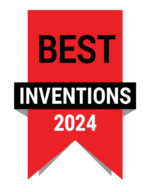$1 Million Dollar Savings for Insurance Funded Remediation Project through Use of In Situ Chemical Oxidation and Enhanced Reductive Dechlorination
Combined Remedies Treat PCE Contamination at Active Dry Cleaner
Project Highlights
- Combined Remedies Approach (ISCO & ERD) implemented in unison near and below active dry cleaning facility.
- Sustained reduction of contaminants below clean-up levels observed 20 months after initial application.
- ISCO & ERD approach approximately $1,000,000 less expensive than proposed dual-phase extraction system option.
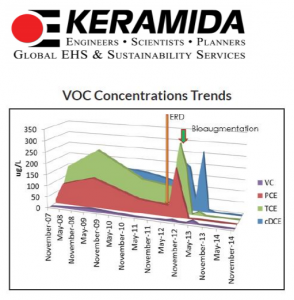
Project Summary
An active dry cleaner site located within a multi-use commercial development strip mall was impacted with high levels of PCE vapors. A subsequent investigation revealed groundwater impacts below the building and outside the building in a former filter storage area.
The original remediation plan involved a dual-phase extraction system with an estimated cost of approximately $1.3 million. An alternative approach consisting of in situ chemical oxidation (ISCO) coupled with enhanced reductive dechlorination (ERD) was proposed by KERAMIDA and ultimately selected by the funding source. To date, the ISCO/ERD approach has cost less than $200,000, including 2 years of monitoring and multiple indoor air/sub-slab vapor sampling events. $50,000 – $75,000 in additional remediation/monitoring is anticipated to achieve closure, resulting in an estimated total savings of $1,000,000 for this project being funded by insurance companies.
Remediation Approach
KERAMIDA developed a remediation work plan consisting of an ISCO injection into the permeable fill material directly beneath the floor of the dry cleaning space (Source Area), combined with a plume-wide ERD injection.
Injection points for both RegenOx® and 3-D Microemulsion® were installed inside the dry cleaner because there was insufficient clearance for the drilling equipment. The remainder of the ERD injection points outside the building were advanced using direct push technologies.
After approximately six months of post-injection monitoring, the data suggested insufficient bacteria were present to promote accelerated reductive dechloriation. Consequently, the bioaugmentation substrate BDI Plus was applied within the ERD treatment area. Graph to the right shows results from key well within this area.
As indicated above, the bioaugmentation substrate rapidly reduced the daughter products generated as a result of the initial electron donor injection. Two years of groundwater monitoring has been performed since the initial injection and CVOC concentrations in all of the wells, except one source-area well, are below the onsite remedial standard (groundwater migration to indoor airscreening level). In addition, two downgradient wells just outside the treatment area have slightly elevated TCE and VC concentrations.
A small supplemental injection is currently planned for the source area (to further reduce the VC concentration to below the screening level) and around the two off-site wells to reduce the minor cVOC concentrations to below residential levels so that deed restrictions are not required.
Technology Description
3-D Microemulsion is an engineered electron donor material that offers a novel 3-stage electron donor release profile, pH neutral chemistry and is delivered on-site as a factory-emulsified product.
RegenOx is an advanced chemical oxidation technology that destroys contaminants through powerful, yet controlled chemical reactions and not through biological means. This product maximizes in situ performance while using a solid alkaline oxidant that employs a sodium percarbonate complex with a multi-part catalytic formula.
Bio-Dechlor INOCULUM Plus is an enriched natural microbial consortium containing species of Dehalococcoides sp. (DHC). This microbial consortium has since been enriched to increase its ability to rapidly dechlorinate contaminants during in situ bioremediation processes.
After approximately six months of post-injection monitoring, the data suggested insufficient bacteria were present to promote accelerated reductive dechloriation. Consequently, the bioaugmentation substrate BDI Plus was applied within the ERD treatment area. Graph to the right shows results from key well within this area.
As indicated above, the bioaugmentation substrate rapidly reduced the daughter products generated as a result of the initial electron donor injection. Two years of groundwater monitoring has been performed since the initial injection and CVOC concentrations in all of the wells, except one source-area well, are below the onsite remedial standard (groundwater migration to indoor airscreening level). In addition, two downgradient wells just outside the treatment area have slightly elevated TCE and VC concentrations.
A small supplemental injection is currently planned for the source area (to further reduce the VC concentration to below the screening level) and around the two off-site wells to reduce the minor cVOC concentrations to below residential levels so that deed restrictions are not required.
About the Consultant

KERAMIDA Inc. is an engineering and consulting firm that serves industries, businesses, cities, and governments worldwide. They provide strategy and implementation services in: Sustainability, Green House Gases, Energy, Environmental Compliance, Remediation, Environmental Due Diligence, Brownfield Redevelopment, Plant Decommissioning, Health & Safety, Training, Risk Management, and ISO Management Systems. Established in 1988, KERAMIDA is headquartered in the historic Lockerbie Square district of Indianapolis, Indiana. The firm employs over 70 technical experts and support personnel in offices throughout the U.S., including Chicago, IL; Pittsburgh, PA; New York, NY; Los Angeles, CA, Sacramento, CA. KERAMIDA’s many principals have worked for over 25 years in the sustainability, environmental, health & safety, and remediation arenas, and are recognized leaders in their fields. Their engineers, scientists, and planners are renowned for delivering creative, integrated EHS solutions to a broad range of clients throughout the U.S. and abroad.
Combined Remedies Approach (Dual Phase Extraction, ISCO and ERD) Lead to Rapid Results on a Guaranteed Cost to Closure Project in Indiana
3- D Microemulsion, BDI Plus and RegenOx Reduce cVOC Concentrations
Project Highlights
- Guaranteed cost to closure project.
- ISCO coupled with dual-phase extraction was successful in reducing cVOC concentrations within the core source area.
- Plume-wide ERD injection resulted in meeting remedial goals within 18-20 months.
- Combined remedy approach (ISCO & ERD) accelerated the time to closure allowing project to be completed within budget
Project Summary
A plating plant in Batesville, Indiana was contaminated with chlorinated VOCs. A subsequent investigation identified a plume of TCE extending from the building approximately 250 feet down gradient (off-site and onto private property across a street).

Remediation Approach
The initial remedial approach involved installation and operation of a dual-phase extraction (DPE) system throughout most of the plume area (26 extraction wells), which operated for approximately 1 ½ years. Approximately one year after the DPE system installation, a core area in situ chemical oxidation (ISCO) injection of RegenOx® was performed by KERAMIDA and Regenesis Remediation Services (RRS). ISCO combined with further operation of the DPE system was effective in additional reductions of cVOC concentrations in the groundwater. Upon conclusion of these efforts, the DPE system was shut down to allow for enhanced reductive dechlorination process to take place.
A successful enhanced reductive dechlorination (ERD) pilot test with 3-D Microemulsion® and BDI® Plus was performed around two off-site wells at the leading edge of the plume. Based on the success of this test, an ERD injection was performed in a newly-identified source area with outstanding results in the first six months. Consequently, the DPE system remained shut down and a full-scale ERD injection was performed in the core area of the plume.
Approximately 9 months after the full scale injections, a very small supplemental injection was performed in the off-site area where the pilot study was done and another in an area where no injection was performed. One year after the full-scale ERD injection, cVOC concentrations are below the target cleanup levels in all wells with the exception of two slightly elevated VC concentrations, which are expected to decrease shortly.
Technology Description
3-D Microemulsion is an engineered electron donor material that offers a novel 3-stage electron donor release profile, pH neutral chemistry and is delivered on-site as a factory-emulsified product.
RegenOx is an advanced chemical oxidation technology that destroys contaminants through powerful, yet controlled chemical reactions and not through biological means. This product maximizes in situ performance while using a solid alkaline oxidant that employs a sodium percarbonate complex with a multi-part catalytic formula.
Bio-Dechlor INOCULUM Plus is an enriched natural microbial consortium containing species of Dehalococcoides sp. (DHC). This microbial consortium has since been enriched to increase its ability to rapidly dechlorinate contaminants during in situ bioremediation processes.
About the Consultant
 KERAMIDA Inc. is an engineering and consulting firm that serves industries, businesses, cities, and governments worldwide. They provide strategy and implementation services in: Sustainability, Green House Gases, Energy, Environmental Compliance, Remediation, Environmental Due Diligence, Brownfield Redevelopment, Plant Decommissioning, Health & Safety, Training, Risk Management, and ISO Management Systems. Established in 1988, KERAMIDA is headquartered in the historic Lockerbie Square district of Indianapolis, Indiana. The firm employs over 70 technical experts and support personnel in offices throughout the U.S., including Chicago, IL; Pittsburgh, PA; New York, NY; Los Angeles, CA, Sacramento, CA. KERAMIDA’s many principals have worked for over 25 years in the sustainability, environmental, health & safety, and remediation arenas, and are recognized leaders in their fields. Their engineers, scientists, and planners are renowned for delivering creative, integrated EHS solutions to a broad range of clients throughout the U.S. and abroad.
KERAMIDA Inc. is an engineering and consulting firm that serves industries, businesses, cities, and governments worldwide. They provide strategy and implementation services in: Sustainability, Green House Gases, Energy, Environmental Compliance, Remediation, Environmental Due Diligence, Brownfield Redevelopment, Plant Decommissioning, Health & Safety, Training, Risk Management, and ISO Management Systems. Established in 1988, KERAMIDA is headquartered in the historic Lockerbie Square district of Indianapolis, Indiana. The firm employs over 70 technical experts and support personnel in offices throughout the U.S., including Chicago, IL; Pittsburgh, PA; New York, NY; Los Angeles, CA, Sacramento, CA. KERAMIDA’s many principals have worked for over 25 years in the sustainability, environmental, health & safety, and remediation arenas, and are recognized leaders in their fields. Their engineers, scientists, and planners are renowned for delivering creative, integrated EHS solutions to a broad range of clients throughout the U.S. and abroad.
ISCO Treatment Achieves Closure on Arizona Superfund Site
Benzene Contamination Treated to Non-Detect with Single PersulfOx® Application
Project Highlights
- Previous remediation attempts included soil vapor extraction coupled with groundwater pump and treat/air sparging.
- PersulfOx was applied via gravity-feed through existing remediation wells.
- Single application of PersulfOx resulted in benzene reductions of 1,000 ug/L to non-detect.
- Site closure achieved
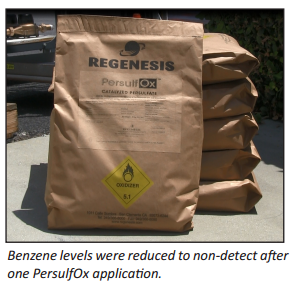
Project Summary
Persistent benzene contamination at an Arizona Superfund Site kept the state regulatory agency from closing the site. The City of Tucson maintenance yard contained low residual concentrations of benzene around 1,000 ug/L in a single well. An initial remediation approach used soil vapor extraction coupled with groundwater P&T and air sparging, however results did not meet site closure criteria.
When considering alternatives, the State of Arizona wanted to be efficient by using the existing remediation wells. As a result, Regenesis worked with the state to design a PersulfOx application using the existing infrastructure. Regenesis worked with the state to design and assist with the application of PersulfOx® using the existing remediation wells. After one application, benzene contamination levels were non-detect in the offending well and site closure was achieved.
Remediation Approach
The treatment approach was a trial by the State of Arizona to apply PersulfOx via gravity-feed directly into the existing remediation wells to target residual benzene concentrations. By using the existing in situ infrastructure, the cost of the one-time PersulfOx application was less than $15/cubic yard.
Technology Description
PersulfOx is a sodium persulfate-based chemical oxidation technology which destroys both hydrocarbon and chlorinated solvent-type contaminants in the subsurface. PersulfOx contains a built-in catalyst which activates the persulfate component and generates contaminant-destroying free radicals without the need for the addition of a separate activator.
Dissolved-Phase Petroleum Hydrocarbons in Clay Treated with Enhanced Aerobic Biodegradation Using ORC® Advanced
Site Closure Pending Post-Treatment at California Retail Store Location
Project Highlights
- Dual-phase extraction had been used on-site, however BTEX contamination concentrations remained high.
- Enhanced aerobic biodegradation using ORC Advanced applied via directinjection into clay soils.
- Post-ORC Advanced Application, BTEX groundwater concentrations below 10 ug/L.
Site closure pending.
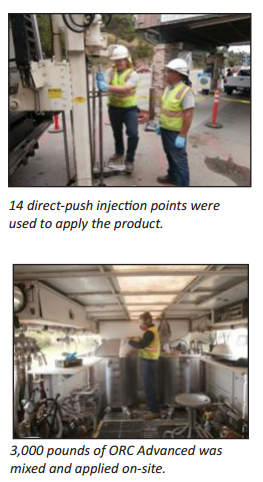
Project Summary
The Cambria General Store in Central California had a history of petroleum hydrocarbon contamination. Dual-phase extraction had been used in the past to treat the site and a total of 130 pounds of petroleum hydrocarbons were removed. However, contamination levels remained above regulatory levels. Contaminant concentrations included: benzene at 310 ppb, toluene at 8,000 ug/L, ethylbenzene at 2,700 ug/L and xyelene at 12,000 ug/L. THPg levels were measured as high as 14,000 ug/L on-site. The site was successfully treated with ORC Advanced which reduced BTEX groundwater concentrations below 10 ug/L. Site closure is pending.
Remediation Approach
ORC Advanced was used to treat the residual dissolved-phase groundwater to California’s low threat groundwater levels. It was applied to two areas within a 1,200-square-foot treatment area. A total of 14 injection points were used to apply a total of 3,000 pounds of ORC Advanced with injection spacing of 7.5 feet on center.
Technology Description
ORC Advanced is a proprietary formulation of food-grade, calcium oxy-hydroxide that produces a controlled-release of molecular oxygen for periods of up to 12 months upon hydration. This newly available source of oxygen is available for aerobic microorganisms to metabolize along with the unwanted petroleum hydrocarbons.
Regenesis Remediation Services™ – TCE-Impacted Soil Treated with RegenOx®
In Situ Chemical Oxidation Significantly Reduces Contamination Concentrations at Former Manufacturing Facility Site
Regenesis Remediation Services (RRS) was contracted to design and perform in situ chemical oxidation (ISCO) via soil mixing to remediate trichloroethylene (TCE) impacted soils at a former manufacturing site in Hamilton, Ohio. RegenOx® was selected as the primary remediation technology based on site conditions, and the treatment area focused on soilbound TCE contamination averaging 86 mg/kg in the sandy-silt to clay-rich unsaturated soils. The remediation objective was to reduce TCE levels in the soil to below the maximum concentration for Toxicity Characteristic Leaching Procedure (TCLP) of 0.5 mg/L, to allow for subsequent off-site disposal.
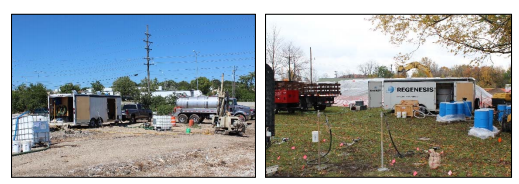
The impacted soils were treated in-place by a hydraulic excavator with a specialized mixing attachment. RegenOx was evenly dispersed throughout the contaminated soil, then thoroughly mixed using the excavator attachment. Once mixing was complete, the soils were hydrated with a RegenOx solution, to maximize oxidant loading to achieve aggressive remediation goals. As a result of the soil mixing procedures, a 99% reduction in soil concentrations was achieved. RRS remediated approximately 670 cubic yards of TCE-impacted soil on this real estate redevelopment project. Soil mixing was performed primarily from 4 feet to 8 feet below ground surface (bgs) over an area of approximately 4,500 square feet. Construction activities were able to proceed on schedule due to RRS’s well managed application and proper use of the RegenOx chemistry.
Regenesis Remediation Services™ – TCE Impacted Soil Treated with RegenOx®
Soil Mixing Using In Situ Chemical Oxidation Reduces Contamination Concentrations at Former Manufacturing Facility
Regenesis Remediation Services (RRS) was asked to design and implement a pilot test as well as a full scale design for a soil mixing project using in situ chemical oxidation (ISCO) technology. The specific goal of the remediation plan was to reduce trichloroethylene (TCE) levels to less than .5 ppm, to meet standards for off-site removal as non-hazardous waste. The design included the use of RegenOx® Part A and B as an oxidant in a pug mill system. The TCE at this former manufacturing facility was present from two (2) feet below ground surface (bgs) down to eleven feet bgs in certain areas.

A total of 27,950 pounds of RegenOx Part A and 7,260 lbs of RegenOx Part B were applied over 39 discrete treatment cells during the course of the remediation project. Using an excavator, the top two feet of soil was removed and stored separately, after which the contaminated soil could be excavated and treated with RegenOx Part A and B in a pug mill system. Using RegenOx as an oxidizer, TCE on site was remediated using oxidation to dechlorinate TCE to dichloroethene (DCE), vinyl chloride (VC), and finally to ethene, a benign end product. Two years later, soil samples came back clean and the soil could be trucked off site as non-hazardous waste.
Regenesis Remediation Services™ – PCE Treated with RegenOx®
Soil Mixing Using In Situ Chemical Oxidation Reduces Contamination Concentrations at Former Dry Cleaning Facility
Regenesis Remediation Services (RRS) was hired for this large-scale soil mixing project to treat tetrachloroethylene (PCE) in shallow surface soils. The application used in situ chemical oxidation (ISCO) technology to oxidize residual chlorinated solvents at this former dry cleaner site. The goal was to reduce chlorinated volatile organic compounds (cVOCs), particularly PCE, from >20 ppm to less than 5 ppb. The design of the project was divided into a grid with twelve sections, each 25 feet (ft.) by 21.5 ft., and 5 ft. deep.

Using RegenOx® remediation chemistry and an excavator to complete the soil mixing, the impacted soils were removed by an excavator and a proportional amount of RegenOx was evenly dispersed throughout the excavated soil, then thoroughly mixed using the excavator.
Once mixing was complete, the soils were placed back into the treatment cell while being hydrated with a RegenOx solution made up of RegenOx, water and hydrogen peroxide. By optimizing the contact between the soil, contaminants, and RegenOx, powerful desorption effects strip PCE off of the soil matrix and onto the RegenOx catalytic surface. This catalytic surface contributes to localized free-radical generation, leading to focused and efficient contaminant destruction via soil mixing. After eight days of the completion of the project, 98-100% reductions were achieved in the twelve sections of the grid.
Regenesis Remediation Services™ – PCE Plume Treated with RegenOx®
In Situ Chemical Oxidation Reduces Contamination Concentrations at a Former Dry Cleaner Site
Regenesis Remediation Services (RRS) was contracted to design and perform in situ chemical oxidation (ISCO) via soil mixing to remediate tetrachloroethylene (PCE) impacted soil at a former dry cleaner site located in Cook County, Illinois. RegenOx® was chosen as the primary remediation technology for the chemical oxidation. The treatment area focused on soilbound PCE contamination around 1,170 mg/kg in the clay-rich unsaturated soils. The soil remediation objective was to reduce PCE levels below the 240 mg/kg soil saturation limit established by the Illinois EPA.
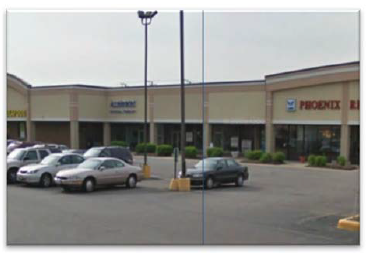
The impacted soils were removed by a mini trackhoe excavator and placed inside a vacant unit adjacent to a treatment cell where the soil mixing was performed. A proportional amount of RegenOx was evenly dispersed throughout the excavated, contaminated soil, then thoroughly mixed using the excavator. Once mixing was complete, the soils were placed back into
the treatment cell while being hydrated with a RegenOx solution.
By optimizing the contact between the soil, contaminants, and RegenOx, powerful desorption effects strip PCE off of the soil matrix and onto the RegenOx catalytic surface. This catalytic surface contributes to localized free-radical generation, leading to focused and efficient contaminant destruction. Approximately 242 cubic yards of soil bound contaminant mass was successfully treated at this site. Soil mixing was performed from surface grade to approximately 10 feet below grade.
Regenesis Remediation Services™ – LNAPL Recovery at an Active Gas Station
Combined Treatment Remedies Reduce Contamination Concentrations at Michigan Service Station
Regenesis Remediation Services (RRS) was contracted to remediate a residual LNAPL and dissolved-phase petroleum plume from historic gasoline and diesel fuel releases at an active service station. RegenOx PetroCleanze™ (PetroCleanze) was chosen as the primary remediation technology to facilitate the recovery of residual LNAPL and chemically oxidize contaminants without negatively impacting sensitive infrastructure.

The design called for three (3) application events using PetroCleanze, with Oxygen Release Compound (ORC®) Advanced applied during the final application event in a down-gradient plume cut- off barrier, to promote the enhanced aerobic biodegradation of dissolved-phase petroleum hydrocarbons. Eight (8) injection/extraction wells and 28 direct-push technology (DPT) injection points were used to apply the remediation reagents in the silty-sand aquifer and smear zone. Vacuum extraction was conducted between PetroCleanze applications to recover residual freephase petroleum hydrocarbons liberated from the soils. Reagent distribution monitoring confirmed PetroCleanze was present throughout the targeted source area during each application event.
Prior to the first PetroCleanze application event, no measurable free product was observed at this site since 2006. Less than twenty-four hours after the first PetroCleanze application event, LNAPL up to three inches thick was observed in four of the eight wells. After completing the third application and extraction event, LNAPL was not observed in any wells on site, and BTEX concentrations in groundwater were showing reductions for the first time since the fuel releases first occurred. A total of 2,160 pounds of RegenOx PetroCleanze and 1,120 lbs. of ORC Advanced were injected.
Regenesis Remediation Services™ – LNAPL Recovery & In Situ Chemical Oxidation
Combined Treatment Remedies Reduce Contamination Concentrations at a Former Service Station
Regenesis Remediation Services (RRS) was contracted to remediate a dissolved-phase and residual LNAPL petroleum hydrocarbon plume resulting from historic petroleum fuel releases at a former service station. RegenOx® PetroCleanze™ (PetroCleanze) was chosen as the primary remediation technology in addition to Oxygen Release Compound (ORC®) Advanced, to facilitate recovery of residual LNAPL and chemically oxidize contaminants without negatively impacting sensitive infrastructure. ORC Advanced was applied during the second PetroCleanze application to promote the enhanced aerobic bioremediation of dissolved phase petroleum hydrocarbons.
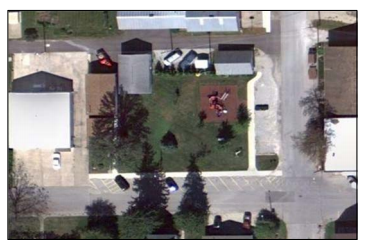
Eighteen direct-push injection points were used to apply the reagents in the silty sand aquifer and saturated soil over the course of two application events. Vacuum extraction was conducted after each PetroCleanze application to recover residual free-phase petroleum hydrocarbons liberated from the soils. Reagent distribution monitoring during the application events confirmed PetroCleanze was present across the targeted source area. Remediation chemistry was applied via direct-push injection points with a bottom-up approach from 5 to 15 feet below ground surface (bgs). A total of 4,470 pounds (lbs.) of RegenOx PetroCleanze and 720 lbs. of ORC Advanced were injected throughout the course of the two applications.

 Americas
Americas Europe
Europe Français
Français Deutsch
Deutsch Italiano
Italiano Español
Español



